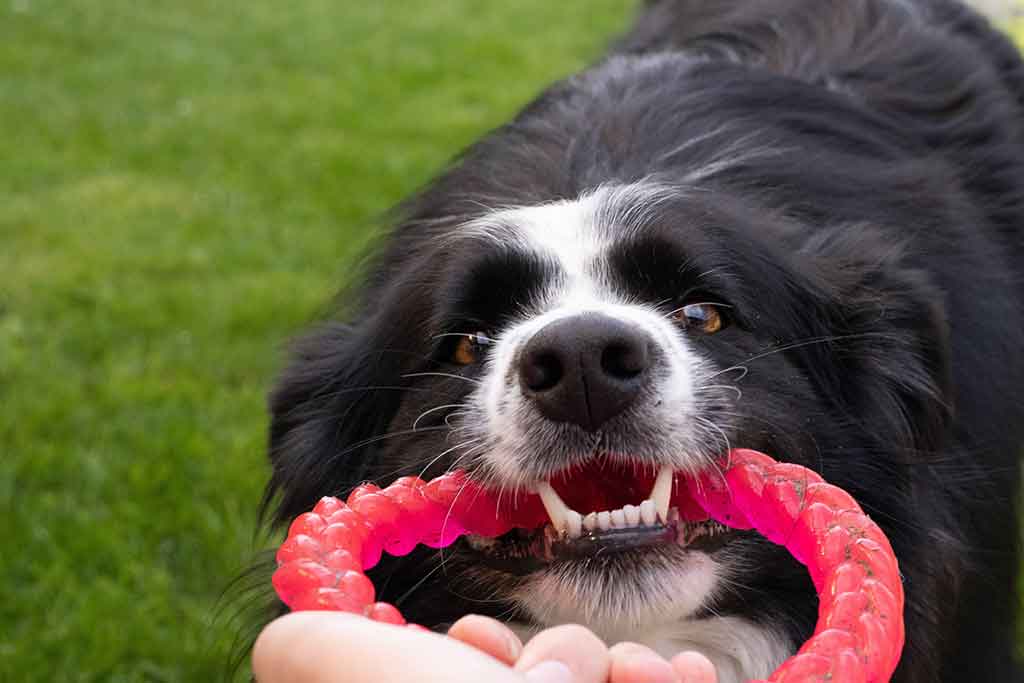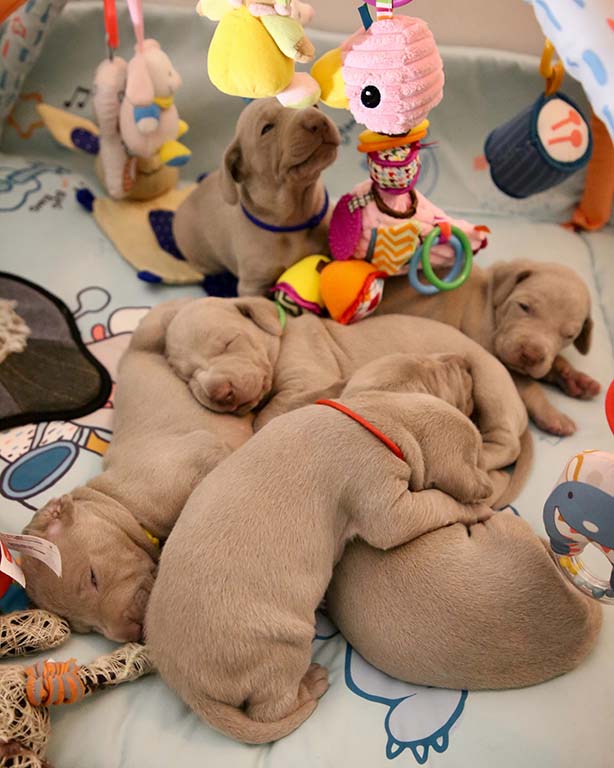How Does Mental Stimulation For Dogs Work?

I enjoy coming up with creative enrichment ideas for my…
You can do mental stimulation for dogs by using enrichment activities to exercise their brain.
This is something you want to consider doing because many dogs these days are kept as pets.
They don’t have a job working alongside us like their ancestors once did, which is why we need to make sure that our dogs get mental exercise as much as physical exercise.
Furthermore, many dog owners live in cities, which means it’s often easier to provide your dog with adequate mental exercise rather than physical exercise.
Note that this doesn’t mean that you should forget about physical activity. It’s just as important.
But if you live in an apartment or a small block of land, there’s only so much physical exercise you can provide your dog with on the daily.
What Is The Meaning Of Mental Stimulation?
The meaning of Mental Stimulation is to make your dog’s life better, more rewarding and meaningful through Enrichment Activities. There are many different types of enrichment activities:
- Sensory (Scent Games, Sniffing)
- Social (Meeting other dogs and people)
- Environmental (Making their environment more interesting), and
- Feeding (Kongs, Snuffle Mats)
These enrichment activities are often used together, they’re not exclusive, and some very simple things can make a real difference.
For example, you can weigh out your dog’s daily food, and instead of giving it to your dog in a bowl, you can hide it around the house as well as doing little training sessions with food rewards. Literally, anything that allows your dog to use his amazing brain.
Why Do Dogs Need Mental Stimulation?
Dogs need mental stimulation because like all other animals, they need something interesting to do with their day. If they don’t receive adequate mental stimulation, dogs often develop behavioural problems and mental problems, such as destructive behaviour, depression, stress, and separation anxiety (American Kennel Club – A Mentally Stimulated Dog Is a Happy Dog).
Through mental stimulation, we can allow our dogs to use their fantastic brain and in doing that we make their life more enjoyable.
How Can I Stimulate My Dog When I’m Not Home?
Dogs don’t typically entertain themselves when they’re alone. While there are a few things that you can try to stimulate your dog when you’re not home, it’s usually better to focus on stimulating activities when you’re together with your dog.
For example, if you do some enrichment activities before leaving your dog home alone, your dog will be more likely to rest and relax while you’re out of the house.
In most cases, that’s all you want. What if you had a calm dog who’s happy to doze away while home alone, rather than showing signs of stress and destructive behaviour?
Usually, the only enrichment activities for stimulation that you can get your dog to be interested in on his own involve food.
This means that you can try leaving your dog with some enrichment feeding activities, like Kongs and snuffle mats. That said, this will only keep your dog stimulated for a short time.
Stimulation before you leave the house
Rather than trying to stimulate your dog while you’re not home, try some enrichment activities before you leave the house. Most dogs wake up energetic and excited for the day, so it helps to burn some of that energy before your dog is being left on his own devices.
For example, you could take your dog on an early morning walk with lots of opportunities to sniff, followed by enrichment feeding him his breakfast, scattered around the house or backyard.
Strong Entry and Exit Routine
Many dogs show signs of destructive behaviour and separation anxiety because they don’t know what’s happening to them. Once their owner leaves the house, they start to panic because they think that they’ve been left behind.
If you teach your dog a stable, predictable routine for when you leave the house, it can build up your dog’s confidence and reduce if not wholly prevent separation anxiety from happening.
You do that by completely starting from scratch with a new routine and cue word. For example, tell your dog to go to his place, give him a high-value treat, and then leave the house. Come back inside after just a minute, but be careful only to come back when your dog is quiet. You don’t want your dog to think that his barking or whining made you come back into the house.
From here on, you slowly build up the period that your dog is being left alone. If all goes well, you’ll soon have a dog who will happily go to his place and await his treat when you’re getting ready to leave.
Note that it’s also essential to not make a big fuss when you come back inside the house. You basically want to teach your dog that it’s a good thing when you’re leaving (he’s getting a treat), and it’s unspectacular when you’re coming back home.
How Can I Keep My Dog Entertained In The Yard?
Don’t be fooled by companies trying to sell you products with the sole purpose of entertaining your dog while they’re home alone. Dogs are pack animals and have a strong bond with their human, which means that most of them couldn’t care less about entertainment if they’re home alone. Most dogs will just ‘hang out’ until their human comes back home.
That said, there certainly are dogs and situations in which boredom will cause stress and lead to destructive behaviour. Furthermore, there are a few inexpensive, easy things you can do to provide your dog with some mental stimulation in the yard. Anything that will get your dog to use his brain will eventually make him more tired, which will make it easier for your dog to settle and reduce stress.
Scatter Hunt
Before you leave the house, try hiding your dog’s breakfast and/or different value treats in various locations throughout the backyard. Dogs have fantastic noses, so in doing that you’re creating a sniffing scatter hunt for your dog.
On top of that, every time your dog finds new, it’s releasing happy hormones in his brain, which furthermore reduces the stress hormones that might be present due to being home alone. You can learn more about scatter hunts in another article I wrote here: Scatter Hunts: Save Your Dog From Boredom
Rotate Toys
Instead of giving your dog constant access to all his toys, rotate them. Furthermore, similar to the scatter hunt, you can hide the toys in the backyard before you leave.
How Do You Stimulate A Dog Indoors?
How you can stimulate your dog indoors will depend on where you keep him. That said, it shouldn’t matter if your dog has full access to all rooms or just a single place.
As long as you have a strong entry and exit routine, as well as adequate stimulation before you leave the house, your dog will likely doze away until you come back home.
If your dog is showing signs of stress when you leave him home alone, your best bet is to leave him with a long-lasting chew treat. Chewing releases endorphins in your dog’s brain, which help to reduce the stress hormones, so will make your dog more likely to calm down and settle.
Do Dogs Get Sad When They Are Alone?
I mentioned several times that your dog would likely just hang out and wait until you come back home, rather than entertaining himself while he’s home alone. Does that mean that dogs get sad when they are alone?
Well, dogs are living beings who certainly exhibit emotions. It’s hard to say if a dog can feel the same type of sadness that a human feels, but they certainly feel negative and positive emotions.
Furthermore, since dogs are pack animals, it’s fair to assume that being left alone will likely cause them to experience negative rather than positive emotions.
That doesn’t mean that dogs aren’t capable of spending time alone, but it means that you should monitor your dog, and if you’re concerned about his behaviour it’s best to consult a behaviourist vet.
Dog depression is a real thing, and a depressed dog might become aggressive, so get on top of it while you can.
Do Dogs Sleep When Bored?
Yes, dogs often take a nap when they’re bored. Dogs sleep patterns are different from ours. They sleep more, and they’re more flexible in how they get their sleep.
Dogs are much quicker to wake up than we are. We go through long, deep sleep periods. Dogs don’t typically sleep through such long stretches, and they get to deep sleep much quicker.
For example, on average, it takes humans about 70-90 minutes after falling asleep to get into a deep sleep. Dogs get there in just about 10 minutes. So they’re more flexible with their sleep patterns and often sleep when they’re bored.
What's Your Reaction?
I enjoy coming up with creative enrichment ideas for my dogs. DIY & Crafting has always been a big part of my life since I was a child.





